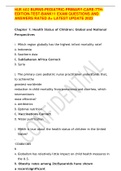Samenvatting
Summary of Operations Strategy - Nigel Slack & Michael Lewis - Operations Strategy and Technology(EBB109A05) - University of Groningen
- Instelling
- Rijksuniversiteit Groningen (RuG)
- Boek
- Operations Strategy
Summary of the book "Operations Strategy " - Nigel Slack & Michael Lewis. The summary covers the whole book, that is, chapters 1,2,3,4,5,6,7,8,9,10. Originally, the summary was written for the subject Operations Strategy and Technology(EBB109A05), University of Groningen.
[Meer zien]














